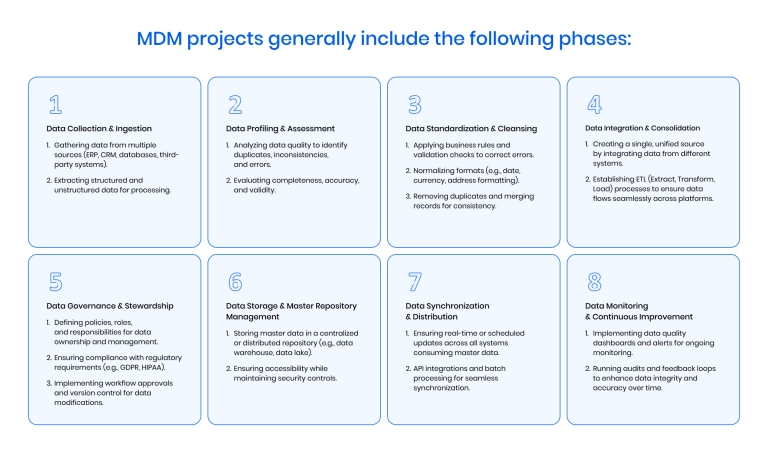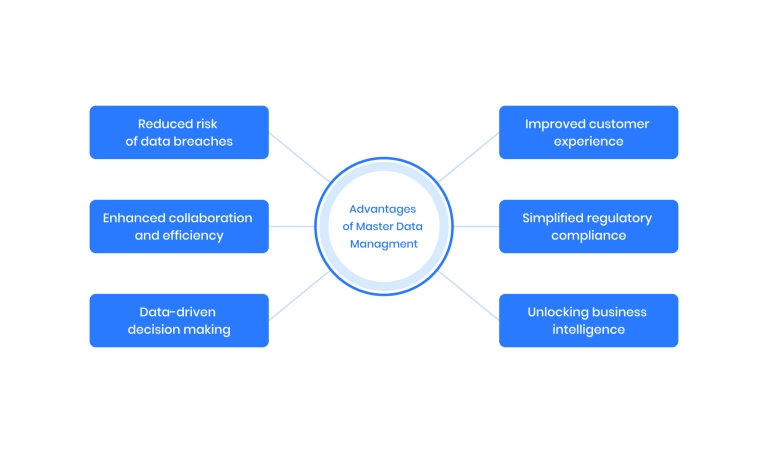Master Data Management (MDM) is a method that allows companies to link all critical data within one master file that serves as a common point of reference across systems.
Without proper MDM, businesses may suffer from inconsistencies and duplicates, especially with vast volumes of big data scattered across departments. MDM consolidates data from multiple systems, creating a single, consistent source of truth.
Some of the scenarios that trigger the need for master data management implementation are:
- A company with multiple brands that is having trouble with rapid expansion.
- A need to combine data from multiple sources during merger and acquisition.
- Overall poor quality of data.
This article discusses what master data management means for big data and how to go through MDM data integration without challenges and with a maximum result.
The challenges of managing big data without MDM
To make a case for MDM, let's see what potentially happens with big data when MDM is not implemented:
Fragmented customer profiles & data duplication
One of the most significant challenges, particularly for retail and global enterprises, is creating a unified customer profile.
For instance, a customer might sign up on one e-commerce site with a typo in their email address and later register on another branch using the correct email but a different phone number. Without MDM, businesses struggle to identify and merge these fragmented records.
Impact:
- Difficulty creating a unified customer view for personalized marketing and customer service
- Increased storage and processing costs due to redundant enterprise data
How MDM helps overcome this:
- MDM leverages AI to merge customer variations.
- It ensures consistent formatting for addresses and phone numbers across all platforms.
- MDM validates emails and phone numbers before they're entered into the database.
- It automatically reconciles customer records from multiple systems into one unified profile.
Data inconsistency
Different departments or systems often store conflicting information due to the lack of a single source of truth. For example, finance and marketing departments may have differing sales figures.
Impact:
- Errors in demand forecasting due to conflicting sales data
- Inaccurate financial reports
- Inventory management issues caused by inconsistent product information
Lack of integration between systems
Organizations typically use multiple platforms (ERP, CRM, marketing automation), but without MDM, these systems rarely exchange data effectively, creating data silos.
Impact:
- Inability to build a complete, integrated view of customers or operations
- Difficulty scaling the business due to fragmented infrastructure
- Loss of productivity from manually syncing data between systems
Compliance and regulatory risks
Industries with stringent data privacy and security regulations (such as finance, healthcare, or e-commerce) risk compliance violations when lacking structured MDM.
Impact:
- Increased legal risks and significant financial penalties
- Loss of customer trust due to data breaches or mishandling
- High costs associated with data audits and corrective actions
To illustrate the effectiveness of MDM in addressing some of these challenges, we asked our data expert to share a real-world scenario:
"A global e-commerce retailer was unable to link customer records across their multi-brand store and build golden customer records based on purchase history and customer interactions. These data issues were leading to losing sales, not user-tailored marketing offerings.
To overcome customer data issues, a global CDP (Customer Data Platform) was designed and implemented. We started from the initial design phase, where we collected country-specific data policies and data points and built a plan to integrate data points into global CDP.
Also, to overcome data-related challenges related to customer data matching, global CDP data standardization policies were designed, as well as MDM customer fuzzy matching processes were designed to solve data quality issues (missing data, semantic mistakes). Within the first six months, we shipped the first iteration of CDP, which allowed us to perform customer-tailored marketing campaigns which increased sales, reduced churn, and brought more impact, as it enabled further customer-centric user experiences." – Vadym Kovadlo , Senior Data Scientist.
How MDM works: The core principles
Master data management (MDM) operates through a series of interconnected processes that bring together scattered and inconsistent data from multiple sources, cleanse and standardize it, and store it in a central repository. The core principles of MDM, which are also its stages, include:
- Data collection
- Data integration
- Data standardization
- Data governance
Let's focus more on each principle (stage) and related challenges:
Data collection
The first step in MDM is identifying and gathering master data from all relevant sources. These sources may include:
- Customer databases (CRM)
- Product catalogs (ERP)
- Financial systems
- Supply chain databases
- Third-party data providers
Challenges:
- Identifying inconsistencies across different data sources.
- Managing large volumes of unstructured data.
Data cleansing and standardization
Once collected, the data must be cleaned and standardized to remove errors and inconsistencies. This involves:
- Deduplication – Eliminating redundant records.
- Error correction
- Normalization – Ensuring uniform data formats across all systems (e.g., date formats, address structures).
Challenges:
- Detecting and resolving conflicts between different data sets.
- Ensuring real-time or near-real-time data updates.
Data integration
After standardization, data is integrated into a central MDM hub to synchronize all systems in a single master data source. There are several master data management integration approaches:
- Registry approach – Links data across systems without modifying original sources.
- Consolidation approach – Collects master data into a centralized hub for reporting.
- Coexistence approach – Synchronizes master data between the central hub and operational systems in real time.
- Centralized approach – Stores and maintains all master data in a single, authoritative database.
Challenges:
- Managing MDM data integrations between legacy systems and modern platforms.
- Avoiding disruptions in existing business processes.
Data governance with master data management
Once the data is integrated, data governance services and policies are applied to maintain accuracy and security. Key aspects include:
- Access control
- MDM for data quality monitoring
- Compliance management
- Data stewardship
Challenges:
- Ensuring ongoing compliance with evolving regulatory requirements.
- Managing role-based access across different departments.

Key benefits of master data management for organizations
- Improved data accuracy and consistency: MDM eliminates duplicate and outdated records, reducing reporting errors and improving efficiency.
- Enhanced decision-making: With MDM, organizations gain access to accurate and up-to-date information, allowing leadership to base their decisions on real insights.
- Increased operational efficiency: MDM streamlines business processes by centralizing data and reducing redundancies ( f.e, order management, inventory tracking).
- Better customer experience: MDM helps organizations create a complete customer profile by consolidating data from various touchpoints (CRM, sales, support). This enables personalized marketing, faster issue resolution, and improved customer interactions, increasing retention rates.
- Stronger regulatory compliance and data governance: Industries such as finance, healthcare, and e-commerce must comply with strict regulations (GDPR, HIPAA, SOX). MDM helps enforce data governance policies, ensuring that sensitive information is handled securely and audit trails are maintained to meet compliance requirements.
- Cost savings on data management: MDM minimizes unnecessary storage costs and lowers data maintenance, manual corrections, and IT support expenses. As a result, cost reductions help allocate resources more effectively.
- Seamless integration between systems: Organizations often use multiple software platforms (ERP, CRM, HR systems). MDM facilitates smooth integration between these systems, ensuring data flows consistently across the entire business.
- Faster and more accurate reporting: Inaccurate or fragmented data leads to unreliable reports. MDM ensures that financial, sales, and operational reports are based on clean, consolidated data. It allows businesses to track performance metrics confidently.
- Better risk management and fraud prevention: With accurate and centralized data, businesses can detect anomalies and potential fraud more efficiently. MDM enables organizations to monitor transactions.
- Competitive advantage in the market: Companies that effectively manage their master data can respond faster to market changes.

Key components of a successful MDM strategy
1. Choosing the right MDM tools
Selecting the right MDM solution is the foundation of a successful master data management strategy. Here is how to choose the right MDM solution:
- Identify which data domains (customers, products, suppliers) need management.
- Ensure the tool seamlessly connects with existing ERP, CRM, and analytics platforms.
- Choose a solution that grows with your organization's needs.
- The tool must comply with regulations (such as GDPR and HIPAA).
- A system with a user-friendly interface will increase adoption rates among employees.
Some examples of MDM tools are Informatica MDM, SAP Master Data Governance, IBM InfoSphere MDM, Talend MDM, and Oracle MDM.
2. Setting up efficient MDM processes
Once the data engineering tools are selected, businesses must establish clear MDM workflows to ensure consistency in data handling. Here are the key steps in the process setup:
- Consolidate data from all sources (ERP, CRM, finance, supply chain).
- Remove duplicates, fix errors, and apply formatting rules.
- Define policies for data accuracy and access control.
- Assign data stewards who oversee the quality and consistency of master data.
- Use machine learning, big data, and AI to automate data validation and reduce manual intervention.
Best practice: Start with a pilot project to test the new processes before scaling MDM across the organization.
3. Employee training & change management
Even the best MDM system will fail if employees don't comprehend how to use it. Training and change management are essential for long-term success. Here is how to train the employees for MDM strategy implementation:
- Teach employees based on their involvement (IT team, business analysts, marketers, etc.).
- Do hands-on sessions to demonstrate what needs to be done.
- Provide easy-to-follow manuals on best practices for master data management.
- Foster awareness about the importance of clean data and its impact on business performance.
Best practice: Establish an MDM support team to assist employees and resolve any issues during the transition.
4. Continuous monitoring & evaluation of MDM performance
Once the MDM system is in place, continuous monitoring ensures it remains effective and aligned with business goals. Here are the key performance metrics to track at this stage:
- Data quality score – Percentage of accurate, complete, and duplicate-free data.
- Error reduction rate – Decrease in data inconsistencies and inaccuracies.
- Integration efficiency – Speed and accuracy of data synchronization across systems.
- Compliance adherence – Ability to meet industry regulations and security standards.
- Business impact – Improvements in decision-making, customer satisfaction, and operational efficiency.
Best practice: Schedule regular data audits and use AI-driven analytics to identify patterns in data errors and inefficiencies.
As Vadym Kovadlo, our Senior Data Scientist, explains:
"A critical thing to remember about MDM is that it isn't a one-and-done project but a continuous process that evolves with your business. To maintain high-quality data, companies must track key performance indicators (KPIs) like duplicate reduction, faster data retrieval, and overall data accuracy. Regular process reviews help update policies and workflows as business needs change, and staying up to date with software upgrades ensures you're leveraging the latest features to optimize data quality."
He further states:
"We help businesses stay on top of their MDM strategy by setting up monitoring dashboards, conducting periodic audits, and fine-tuning processes to keep everything running smoothly. The goal? Ensuring your MDM solution delivers measurable value today – and scales without hassles as your business grows."
Master data management and big data: A perfect pair
MDM provides a single source of truth for an organization’s core data – customers, products, suppliers, employees, and more. Without MDM, Big Data can become redundant and difficult to analyze. MDM transforms raw data into meaningful insights. The combination of big data and master data management:
- Eliminates duplicates across datasets
- Cleans and standardizes data before analysis
- Provides structured data for real-time analytics
- Improves accuracy of predictive models.
- Improves data governance
- Simplifies compliance
The value of big data is not in its volume but in its actionable insights. MDM is an effective method of gaining these insights.
Key roles of MDM in big data processing
- Eliminating data silos for a unified view
Big Data is often scattered across multiple platforms (databases, cloud storage, IoT devices, third-party APIs). MDM integrates and consolidates this data, creating a single, unified data repository that all business applications can access.
Example: A retail company collects customer data from online purchases, in-store sales, and mobile apps. MDM ensures that customer profiles remain consistent across all platforms.
- Enhancing data accuracy and trustworthiness
Big Data sources can include inconsistent or incorrect records. MDM cleans and standardizes the information, making sure it is ready for analysis.
Example: A financial institution dealing with millions of transactions daily uses MDM to prevent errors caused by duplicate customer accounts or incorrect financial records.
- Enabling real-time decision-making
Businesses rely on real-time data for dynamic pricing, fraud detection, and personalized customer experiences. MDM ensures that real-time data streams are validated against a trusted master data set.
Example: A healthcare provider using real-time patient data for emergency response needs accurate and up-to-date medical histories, which MDM helps maintain.
- Supporting AI and machine learning applications
AI and machine learning models require high-quality data for accurate predictions. Big data management with MDM ensures that training datasets are error-free, consistent, and properly categorized, improving model performance.
Example: A logistics company using AI for route optimization relies on MDM to maintain accurate traffic, weather, and vehicle data for better decision-making.
Common challenges when implementing MDM
Lack of executive buy-in and business alignment
Many companies treat master data management (MDM) as an IT-driven initiative rather than a business-wide strategy, which results in a lack of leadership support.
How to overcome it?
- Demonstrate MDM's value for decision-making and operational efficiency.
- Engage key stakeholders early to align MDM with business goals.
- Show ROI early – start with a small-scale pilot project or one business unit (e.g., marketing or customer service) to showcase quick wins and encourage investment.
Poor data quality and inconsistent standards
Disorganized data, duplicate records, and missing fields lead to inaccurate insights and operational inefficiencies. Without standardization, data from different departments may conflict.
How to overcome it?
- Conduct a data audit before launching MDM.
- Define standardization protocols on naming conventions, formats, and validation rules.
- Leverage automated data cleansing tools to detect and remove duplicates and ensure real-time updates.
Resistance to change from employees
Employees may resist master data management implementation due to fear of unfamiliar workflows or increased data entry requirements.
How to overcome it?
- Communicate clearly how MDM simplifies daily tasks.
- Offer hands-on, role-based training tailored to each department's specific data tasks.
- Appoint data stewards (MDM advocates) within teams to support adoption.
- Support from top leadership ensures MDM gets funding, resources, and strategic alignment.
Integration issues with legacy systems
Many organizations rely on outdated legacy systems that lack compatibility with modern MDM platforms. This can lead to data silos.
How to overcome it?
- Select an MDM solution with strong integration capabilities – As in cloud-based or hybrid MDM tools that support APIs and middleware. One example of a master data management tool is Informatica MDM.
- Adopt a phased implementation approach – Start by integrating one system at a time to minimize disruptions.
- Use data virtualization for real-time data access across multiple systems without complete migration.
Undefined data governance policies and data security risks
Without clear ownership and rules, businesses struggle to maintain data accuracy during master data management implementation. Industries with strict regulations (e.g., financial services, healthcare, e-commerce) require precise control over data access and storage.
How to overcome it?
- Create a data governance framework with clear policies for data access, ownership, and validation.
- Define access controls – Implement role-based permissions to limit who can edit master data.
- Establish accountability within each department with a clear data owner.
- Perform regular compliance audits.
- Monitor and audit regularly – Use MDM dashboards to track compliance risks and data integrity.
High implementation costs and resource demands
MDM projects require significant financial investment (between $50,000 and $2,000,000+).
How to overcome it?
- Start small and scale gradually – Implement MDM for a single data domain (e.g., customer data) before expanding.
- Use cloud-based MDM solutions – Reduce infrastructure costs with MDM as a Service (MDMaaS).
- Optimize internal resources – Train existing employees to manage MDM rather than hiring new staff.
Difficulties in measuring MDM success
Organizations often struggle to define key performance indicators (KPIs) that measure MDM's impact.
How to overcome it?
- Establish clear KPIs – Track metrics such as data accuracy improvements, duplicate reduction, and efficiency gains.
- Set benchmark goals – Compare pre- and post-MDM performance.
- Use monitoring dashboards – Implement real-time data tracking to assess MDM's effectiveness.
Conclusion
Master Data Management (MDM) is essential for organizations that enhance strategic decision-making by centralizing and standardizing data. To effectively implement MDM within your corporate structure:
- Clearly define business objectives to align data efforts.
- Secure executive support for resources and adoption.
- Integrate MDM seamlessly with existing business processes.
- Adopt a phased approach, starting small before scaling.
- Foster strong data governance through dedicated stewardship and accountability.
To successfully implement Master Data Management (MDM), organizations require specialized expertise in data engineering, governance, and integration—areas where Binariks provides proven support. We provide big data and analytics services and help businesses to:
- Choose and deploy suitable MDM tools and platforms.
- Centralize and organize data, eliminating silos.
- Develop and optimize data integration and governance processes.
- Strengthen data security to prevent breaches.
- Build scalable frameworks to manage data complexity as your business grows.
- Reduce manual data efforts, freeing your teams to focus on strategic initiatives.
Partnering with Binariks ensures your MDM initiative drives measurable business value from big data.
Share


